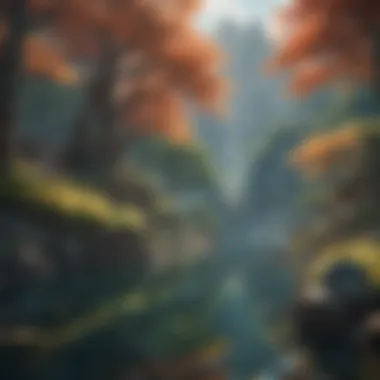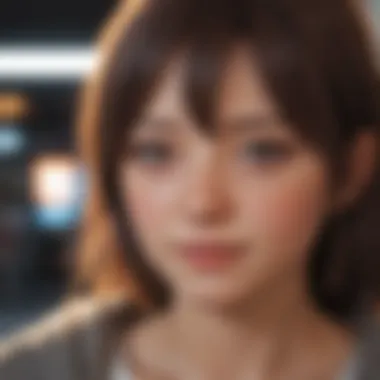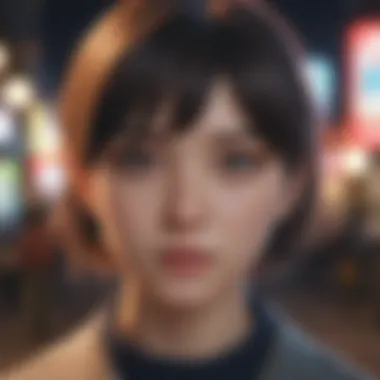Current Landscape of Anime: Top Series to Watch Now


Intro
The world of anime has seen remarkable transformations in recent years. This dynamic medium has attracted a diverse audience, showcasing an array of styles and narratives. As traditional boundaries blur, anime has evolved into an influential part of global pop culture. From stunning visuals to deep and complex storytelling, the best titles today deserve recognition and scrutiny.
Current anime reflects a rich tapestry of themes, genres, and cultural nuances. This article will take you on a detailed journey through the latest trends, must-watch series, and cultural impact of anime in contemporary society.
Industry Insights
Emerging Trends in Anime Industry
The anime industry is continuously adapting to changes in audience preferences and technological advancements. One significant trend is the increased influence of streaming platforms. Services like Crunchyroll and Netflix have expanded access to a wider audience, allowing non-Japanese audiences to explore diverse genres.
Content variety is another notable trend. Viewers now seek stories that resonate on multiple levels, whether through emotional depth or unique narratives. This demand for variety has paved the way for unconventional themes, including mental health, social issues, and identity exploration. Furthermore, the use of sophisticated animation techniques, like computer-generated imagery, has enriched visual storytelling.
Impact of Gaming Technology on Pop Culture
Gaming technology’s integration into anime creation is noteworthy. Titles such as "Sword Art Online" and "Re:Zero – Starting Life in Another World" reflect this synergy, incorporating gaming mechanics into their narratives. This crossover appeal enhances viewer engagement and participation, creating a more immersive experience.
Moreover, the gaming community has begun to influence anime fandoms. Events like anime conventions are drawing fans from both worlds, merging interests and fostering collaboration. Emerging technologies, including virtual reality, hold potential to reshape how narratives are delivered, offering new experiences for fans.
Reviews & Recommendations
Must-Watch Anime Recommendations
As the landscape evolves, several titles stand out. Here are some recommended series to consider:
- Attack on Titan: This series details humanity's struggle against giant humanoid creatures, combining action and political intrigue.
- Jujutsu Kaisen: A tale of sorcerers combating curses, known for its captivating animation and character development.
- Demon Slayer: Follows a young boy on a quest to save his sister from becoming a demon, with stunning visuals that highlight its artistry.
- My Hero Academia: A narrative centered around aspiring superheroes, offering themes of heroism and personal growth.
Movie/TV Show Reviews
The anime film industry has also garnered attention. Movies directed by Makoto Shinkai, such as "Your Name," have captivated audiences with breathtaking storytelling and artistry. Recent releases like "Demon Slayer: Mugen Train" have broken box office records, demonstrating the commercial viability of anime films. These works reflect the industry's growth and the increasing acceptance of anime in mainstream culture.
Closure
The current state of anime underscores its evolution into a multifaceted art form. With advancements in technology and a diversified audience, the industry is ripe for exploration. As this narrative continues to unfold, audiences can expect a plethora of engaging stories that challenge conventions and foster connections across cultural divides. The titles mentioned in this narrative serve as a gateway to understanding the vibrancy and richness of contemporary anime.
Foreword to Contemporary Anime
The current landscape of anime is a complex and dynamic domain that reflects changes in both storytelling and audience engagement. This section highlights the significance of contemporary anime by examining how it adapts to cultural shifts and technological advancements. Today, anime serves not only as a form of entertainment but also as a cultural artifact that resonates globally.
Understanding contemporary anime requires insight into its evolution from niche appeal to mainstream acceptance. This shift has ramifications for both content and the audiences consuming it. Acknowledging these factors is essential as it provides a deeper appreciation for the titles that gain popularity in this ever-evolving medium.
Defining Anime in the Modern Context
Defining anime today involves more than just recognizing it as a style of animation originating from Japan. In the modern context, anime encompasses a variety of genres, themes, and artistic expressions. It includes original series, adaptations of manga or light novels, and even collaborations with Western creators. This broad definition allows for a diverse array of storytelling methods, each with its own unique voice.
Moreover, anime reflects the values and struggles of contemporary society. Many series address issues like identity, mental health, and social dynamics, often translating these themes into accessible narratives for audiences worldwide. This adaptability is what enables anime to remain relevant amid shifting cultural landscapes.
The Rise of Global Anime Consumption
In recent years, the consumption of anime has experienced a significant increase on a global scale. Factors contributing to this rise include the accessibility provided by digital streaming services. Platforms like Crunchyroll, Netflix, and Funimation have made it easier for viewers outside Japan to discover new shows and connect with the anime community.
The influence of the internet cannot be understated. Social media platforms and forums like Reddit facilitate discussion and sharing among fans, creating a vibrant global community. This interconnectedness allows diverse audiences to contribute their perspectives, making anime a truly global phenomenon.
"Anime is no longer confined to Japan; it has become a world-wide form of storytelling that captivates and engages audiences across cultures."


As anime continues to gain traction, it is crucial to explore its varied genres and how they appeal to different demographics, thus laying the groundwork for a deeper discussion on the current offerings in the market.
Criteria for Selection
Selecting standout anime requires careful consideration of several key elements. Each criterion reflects a unique aspect of storytelling, artistry, and cultural significance within the medium. The following criteria are essential in evaluating current anime titles for inclusion in this exploration.
Art Style and Animation Quality
Art style plays a significant role in anime. It is not just about visuals; it can influence the mood and feel of the story. High-quality animation enhances the storytelling experience. For example, series like Attack on Titan showcase intricate animation that complements intense action sequences. Conversely, shows like March Comes in Like a Lion utilize simpler character designs to emphasize emotional depth.
The use of color, character design, and backgrounds contribute to the overall aesthetic. A well-executed visual style can turn a good anime into a visually stunning masterpiece, leading to increased audience engagement.
Storytelling and Character Development
In anime, the narrative is the backbone. Strong storytelling grips viewers and drives them to invest emotionally. Well-crafted arcs and character growth provide depth. For instance, My Hero Academia explores themes of heroism and personal growth through diverse characters, each with distinct motivations.
Developing characters authentically makes them relatable. Viewers resonate with their struggles and triumphs, strengthening the connection to the story. A deep narrative coupled with engaging character arcs keeps audiences coming back for more.
Cultural Relevance and Themes
Cultural relevance is another critical factor. Anime often reflects societal issues or historical contexts, making it not only entertaining but also insightful. Series such as Death Note delve into moral dilemmas, prompting viewers to question justice and ethics.
Themes like friendship, sacrifice, and adversity resonate universally. Whether rooted in Japanese culture or exploring global issues, the most compelling anime often provide commentary on the human experience. This relevance enhances the impact on audiences and solidifies the series' lasting significance.
"The beauty of anime lies not only in its visuals but in its ability to tell stories that resonate across cultures."
Best Anime Series Currently Available
The selection of best anime series currently available is crucial in understanding the evolving landscape of anime. These series not only showcase the variety in genres and styles but also reflect the taste and preferences of audiences worldwide. When discussing standout titles, we consider factors like storytelling quality, character development, and how they connect with contemporary themes. The significance of these series lies in their ability to engage viewers and provoke thought, making them essential viewing for both newcomers and seasoned fans.
Diverse Genres Spanning the Spectrum
Anime today encompasses an expansive range of genres, appealing to diverse audiences. This variety allows for rich storytelling and character exploration that resonates in various ways. Below are subcategories that illustrate this diversity:
Shonen Highlights
Shonen anime often targets younger male audiences, featuring action-packed narratives and themes of friendship, perseverance, and growth. A key characteristic of Shonen highlights is their focus on the hero's journey. Popular series in this category, such as My Hero Academia, exemplify these themes, making this genre a beneficial choice for this article.
The unique feature of Shonen lies in its relatable protagonists and high-stakes conflicts. While many Shonen series may follow a formulaic approach, the emotional depth and growth of characters often stand out. This combination of action and relatability results in a compelling viewing experience, appealing to a broad demographic.
Seinen Innovations
Seinen anime is aimed at adult male audiences, showcasing more intricate storytelling and deeper thematic elements. The hallmark of Seinen innovations is their mature content, often exploring complex societal issues. Titles like Attack on Titan demonstrate this, making Seinen a popular choice for those seeking depth in narrative.
The complex character dynamics and unpredictable plot lines in Seinen provide a unique viewing experience. However, the mature themes might not appeal to all audiences, narrowing its viewer base compared to more mainstream genres. Yet, for those who appreciate nuanced storytelling, Seinen represents one of the best anime offerings today.
Josei and Shojo Essentials
Josei and Shojo anime cater primarily to female audiences, focusing on romance and interpersonal relationships. The essence of Josei and Shojo essentials lies in their character-driven stories that often reflect real-life dilemmas. Series like Fruits Basket exemplify this approach, underlining emotional resonance and personal growth, making these titles invaluable to this article.
The personal relationships in Josei and Shojo often feel grounded and authentic, allowing viewers to connect on a deeper level. While these genres might not always have the same reach as Shonen or Seinen, they play an essential role in highlighting diverse experiences and perspectives in anime.
Top Recommendations
When considering must-watch titles, it becomes apparent that the best anime series not only entertain but also provoke thought and discuss relevant societal themes. This section aims to highlight significant recommendations:
Must-Watch Titles


Must-watch titles serve as the exemplars of what modern anime can achieve. Each series selected here represents high-quality storytelling, impressive animation, and cultural relevance. Titles like Demon Slayer: Kimetsu no Yaiba and Jujutsu Kaisen are noteworthy for their breathtaking animation quality and compelling narratives. These series epitomize what makes the current landscape of anime exciting and innovative.
The unique features of these titles include expertly crafted world-building and complex character arcs. These elements allow viewers to immerse themselves fully in the stories presented. While they are widely popular, not all titles may be as universally engaging, as personal preferences vary, making it vital to consider viewer interests.
Hidden Gems
Hidden gems refer to anime that, despite their quality, may not receive as much recognition as mainstream hits. Titles like Mushishi or A Place Further Than the Universe exemplify this category. They offer rich themes and thought-provoking narratives that might not be as flashy but are equally engaging.
The unique feature of these hidden gems is their ability to present stories that linger in the viewer's mind. While they may not possess the high visibility of more popular series, their depth often resonates more deeply with discerning audiences. This makes exploring hidden gems a rewarding experience for those willing to delve beyond the surface of mainstream anime.
Analyzing Popular Trends
Understanding the current trends in anime is vital for grasping the complexities of the medium. Trends often reflect the shifting tastes of audiences and the industry’s responsiveness to societal changes. This section aims to delve into significant elements shaping contemporary anime, particularly focusing on streaming services and the role of fandom engagement. These factors not only influence the content that is produced but also dictate how it is consumed and appreciated globally.
The Influence of Streaming Services
The advent of streaming services has fundamentally altered the anime landscape. Platforms like Crunchyroll and Netflix have made it easier for viewers to access a broad range of titles from various genres. This accessibility has led to exponential growth in anime's popularity beyond traditional audiences.
With the convenience of streaming, anime is no longer confined to late-night television slots. Users can now binge-watch entire seasons, making series like Attack on Titan or One Punch Man more appealing. This shift in how anime is consumed raises new questions about viewership patterns and engagement.
- Global Reach: Streaming has facilitated the spread of anime to countless viewers worldwide.
- Diverse Offerings: There is a significant increase in the variety of content available, which caters to niche interests, from romance to science fiction.
- Simulcasting: Many platforms now offer simulcasts, allowing fans to access new episodes shortly after they air in Japan. This immediacy strengthens the community's sense of connection with the creators and other fans.
However, this model is not without its challenges. The fierce competition among streaming services can lead to fragmentation, with viewers needing to subscribe to multiple platforms to follow their favorite shows.
Fandom Engagement and Community Impact
The role of fandom in the anime industry is profound. Active fandoms cultivate strong communities, fostering a culture of engagement that impacts trends in significant ways. Online platforms such as Reddit and Facebook host vibrant discussions and fan art, keeping the conversation around series alive long after they air.
The engagement of fans shapes the industry by:
- Driving Trends: Fandoms can significantly influence what gets produced next. If a show gains traction and fervent support, additional seasons or spin-offs are more likely.
- Creating Content: Fans often create their own content, such as fanfiction or cosplay. This not only showcases their passion but also sustains interest in the original material.
- Feedback Loop: Creators often take into account fan reactions and feedback, leading to a more dynamic relationship between anime producers and their audience.
In summary, the combined impact of streaming services and fandom engagement shapes the anime landscape today. Fans now have substantial influence over what is created and how it is consumed. To further understand these dynamics, it’s essential to consider how these trends affect the overall cultural footprint of anime in contemporary society.
"The immense power of fandom can be a double-edged sword, but its capacity to propel lesser-known titles into mainstream attention cannot be overlooked."
As anime continues to evolve, streaming and fan engagement will play pivotal roles in defining its future direction.
Voices of Criticism
The landscape of anime today faces an array of criticisms, which are essential for a deeper understanding of the medium. Critiques are not merely negative evaluations; they serve as a mirror that reflects the industry's strengths and weaknesses. Analyzing these voices sheds light on why certain trends are prevalent and what might be lacking in storytelling, themes, or production quality. By engaging with criticism, audiences can form informed opinions and expectations, encouraging creators to strive for better outcomes.
Critiques of Current Offerings
Narrative Weaknesses
Narrative weaknesses can significantly undermine a series, regardless of its artistic beauty. Many contemporary anime often prioritize spectacle over substance. This focus can lead to plots that feel shallow or disjointed. When the character arcs are poorly structured or the resolutions feel unearned, viewers are left unsatisfied.
The key characteristic of these narrative weaknesses is that they diminish the emotional impact of a story. For example, an anime might have stunning visuals but neglect character development. This absence can create a barrier for viewers who seek a deeper connection to the narrative.
This trend is important for the article because it highlights why certain beloved titles may not always resonate on a deeper level. Furthermore, it presents a unique feature of narrative weaknesses. Many writers believe that compelling drama requires a mixture of relatable characters and cohesive storytelling, which many current offerings fail to deliver. This point can foster discussions around improving narrative structures in future anime productions.
Repetitive Tropes
Repetitive tropes often plague anime, regenerating ideas that lack freshness. The overuse of familiar plot devices, such as the underdog hero or the reluctant savior, leads to a sense of predictability. Audiences might tune out when they feel they have seen it all before.


The main characteristic of repetitive tropes is their ability to create comfort for some viewers, yet they can also lead to frustration for others. While some long-time fans enjoy seeing narratives they recognize, a growing audience seeks innovation and originality. Thus, examining these tropes allows one to see which choices creators make to appeal to established fan bases while possibly alienating new viewers.
In this context, the advantage of addressing this matter is clear. Highlighting this issue encourages creators to explore diverse storylines and more complex character portrayals. Breaking the cycle of repetition enables anime to evolve and maintain relevance in a competitive landscape.
Challenges Facing the Industry
Market Saturation
Market saturation presents one of the most pressing challenges in the anime industry. With a flood of new series and films, distinguishing between quality content and filler becomes difficult for viewers. This saturation can dilute audience attention and may lead to fatigue among fans.
The key element of market saturation is that it forces viewers to sift through an overwhelming amount of content. Identifying what is truly worthy of their time can be a daunting task. Because of this saturation, the demand for unique and innovative storytelling is more significant than ever.
By addressing market saturation in this article, we create an anchor point to discuss how it affects both creators and audiences. As consumers, there is a growing desire for discernment in choices, while creators must strive to rise above the noise.
Quality Control Issues
Quality control issues represent another significant hurdle the industry faces. In the race to produce more content, studios often overlook essential elements like animation quality, voice acting that resonates, and narrative coherence. When shortcuts are taken, the end product usually suffers.
The hallmark of quality control issues is variability in the viewing experience. Some series might launch with high expectations but ultimately disappoint due to rushed production timelines or insufficient resources. This inconsistency can deter viewers and lead to a trust deficit regarding new releases.
Incorporating quality control discussions into this article allows the exploration of why some viewers may hesitate to engage with new titles. By raising awareness of these challenges, both audiences and creators can work towards a more sustainable and rewarding anime landscape.
Cultural Impact of Anime
Anime holds a prominent place in the cultural landscape, shaping and reflecting the interests of a global audience. Its unique storytelling and artistic expressions profoundly influence not just viewers but also various forms of media. The integration of anime elements into Western films, series, and even video games points to its significance as a creative force. In this regard, it is essential to examine how anime resonates with cultural movements, trends, and societal values across different regions.
Influence on Western Media
Anime's impact on Western media cannot be overstated. The fusion of anime aesthetics with storytelling techniques has led to the emergence of a new genre known as "anime-influenced cartoons." Shows such as Avatar: The Last Airbender and Teen Titans showcase the visuals and narratives inspired by anime. These series incorporate complex character arcs and elaborate world-building, which is a hallmark of many anime titles.
Furthermore, film directors like Guillermo del Toro have openly acknowledged their love for anime, often citing it as a source of inspiration for their work. This cross-pollination is evident in animated features that favor detailed animation and rich thematic content, pushing traditional boundaries and drawing in diverse audiences.
"Anime serves as a bridge between cultures, enriching storytelling formats and allowing deeper engagement with genres previously unexplored in Western entertainement."
As more streaming platforms like Netflix and Crunchyroll ramp up anime offerings, the tendency for Western creators to incorporate anime styles grows. Additionally, anime conventions and cultural festivals are now commonplace in cities across the U.S. and Europe, reinforcing its cultural reach and importance.
Anime and Social Commentary
Another significant aspect of anime's cultural impact is its ability to serve as a vehicle for social commentary. Many contemporary anime series tackle issues such as mental health, identity, gender roles, and the anxieties of modern life. For instance, Attack on Titan presents a dystopian view on freedom and societal structures, while My Dress-Up Darling discusses the themes of acceptance through cosplay.
These narratives resonate with audiences who see their struggles reflected in the characters’ journeys. By addressing real-life social issues, anime fosters dialogues about topics often seen as taboo or marginalized in mainstream media.
Ending and Future Outlook
The conclusion is pivotal in this exploration of anime's current landscape. It encapsulates the insights gained and predicts remarkable developments in the medium. As anime continues to grow, understanding its trajectory is essential for fans and creators alike. The significance of evaluating future prospects lies in how the audience engages with content. Engaging narratives and evolving character arcs will likely shape upcoming series. Content creators must respond to changing viewer expectations while maintaining artistic integrity.
What Lies Ahead for Anime
The future of anime appears to be very promising. Technologies continue to advance rapidly, and this evolution directly influences animation quality and storytelling techniques. Virtual reality and augmented reality are beginning to change how audiences experience stories. We may see more series that integrate viewer interaction to create engaging narratives.
Additionally, the continued globalization of anime suggests that international collaboration will increase. Anime studios might merge talents from different regions, thus allowing for unique creative expressions. As streaming platforms become the primary mode of delivery, viewer preferences will dictate trends.
Key areas to monitor include:
- Diversity in Storytelling: Expanding on themes and perspectives previously unexplored.
- Technological Integration: Utilizing new tech for immersive viewing experiences.
- Sustainability: Addressing production issues while remaining eco-conscious.
Final Thoughts on Current Trends
As we reflect on current trends, it becomes clear that anime is more than just entertainment; it is a cultural phenomenon. Audiences are increasingly looking for series that resonate on deeper levels. Themes such as mental health, identity, and social justice are becoming prominent.
Moreover, the advent of social media platforms plays a substantial role in shaping trends. Fandom engagement, discussions on Reddit, and constant feedback shape what becomes popular. This immediacy allows studios to respond to audience wants and needs in real time.
Resources for further exploration:
Wikipedia - Anime
Britannica - Anime
Reddit - Anime Community
Facebook - Anime Groups



